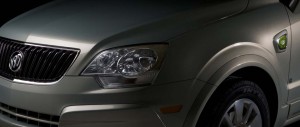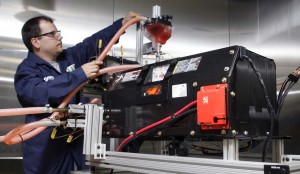
Buick will launch a small crossover in 2010, and a version with a plug-in hybrid powertrain a year later.
General Motors has revealed plans to add a new plug-in hybrid-electric vehicle, or PHEV, to its line-up, a 5-passenger Buick crossover that will go debut in 2011, a year after a conventionally-powered version of the CUV will be launched.
The as yet-unnamed Buick, which GM expects to be the first commercially available plug-in SUV, will share many of its underlying components with the much-touted Chevrolet Volt, though there will be distinct, underlying differences between the two products.
“This will firmly put Buick, and GM, front and center in the advanced technology game,” proclaimed Tom Stephens, GM’s new “car czar,” during a speech at the Management Briefing Seminars, and auto industry confab, in Traverse City, Michigan. “Buick has always been at the forefront of new technology,” he added, “so it is only fitting that the brand should debut our new plug-in hybrid technology in a beautiful new crossover.”

The new Buick crossover will use a downsized version of the lithium-ion battery pack going into the Chevrolet Volt.
Buick is one of only four GM divisions surviving the automaker’s recent bankruptcy. Its sales have slumped significantly, in recent years, so observers say it is not surprising the automaker would make a push to position Buick as a technology leader, as it was during its earlier years.
During his speech, Stephens provided just a sneak peek of the new crossover, which will fit into a niche below the big Buick Enclave – a segment similar to where Chevy’s new Equinox slots in.
“Some customers who have been drawn to the Enclave were looking for something a little smaller,” said Susan Docherty, general manager of Buick and its sister GMC brand.
The version of the CUV debuting in 2010 will be offered with either an Ecotec 2.4-liter Inline-4, or a 3.0-liter V-6. Both feature direct-injection. The base I-4, according to GM estimates, should deliver at least 30 miles per gallon in the EPA’s Highway driving cycle. Specific fuel economy numbers won’t be released until closer to launch.
The plug-in model, due out a year later, could come close to doubling the Buick’s City cycle mileage numbers, to “30 mpg or more,” according to a corporate spokesman. Hybrid technology typically yields little improvement in highway mileage because the electric portion of the powertrain sees little use on the highway.
The plug-in is expected to be able to operate in electric-only mode at speeds up to around 40 mph, that official noted, and will yield up to around 10 miles on battery power alone, under optimum conditions.
That’s about a quarter of the battery range promised for Volt, and reflects the differences between the two products. GM prefers to refer to the Chevy as an “extended-range electric vehicle,” rather than a plug-in. That’s because the wheels are powered, at all times, solely by electric power. Volt’s I-4 engine, when it is used, serves only as a generator, when the batteries are run-down.
In technical terms, Volt is a series hybrid. The Buick is a parallel hybrid. That means its wheels will be able to be driven by electric motors, by its 3.6-liter flex-fuel V-6 engine, or by both. In fact, the CUV uses an updated version of the 2-Mode Hybrid powertrain technology now available on a variety of GM vehicles, including its big Cadillac Escalade Hybrid.
But on the Buick crossover, the system will integrate some critical components borrowed from Volt, notably its advanced lithium-ion battery cells. The Buick’s pack will be able to store 8 kilowatt-hours of energy, about half as much as Volt, in a rectangular-shaped package that will be hidden beneath the CUV’s cargo floor.
“LG Chem – the supplier of our battery cells for the Volt – has also been selected to supply the lithium-ion cells for the new Buick plug-in hybrid, and its Troy, Mich.-based subsidiary Compact Power will supply the pack,” said Stephens, GM’s Vice Chairman of Product Development.
The new plug-in hybrid will also share Volt’s critical charging system. Connected to a common household 110 volt outlet, a motorist will be able to top off the battery in four to five hours.
GM’s announcement comes just a day after Vice President Joe Biden came to Detroit to announce more than $1 billion in federal grants to promote the development of an advanced battery manufacturing base. While some skeptics believe there are still too many uncertainties about lithium technology to predict its long-term roll in the auto industry, a growing list of manufacturers is betting on these batteries to power future products.
Last weekend, Nissan revealed the new Leaf, the electric vehicle the maker plans to put into production in 2010. And, as TheDetroitBureau.com reported, yesterday, Toyota plans to launch its own battery-electric vehicle, or BEV, by 2012. Ford has plans to put both plug-ins and BEVs into its fleet in the next several years, as well.

The elephant in the room here is that the photo GM is showing is a Saturn Vue with a Buick grille and a restyled charging point but not one other visible change, following immediately after it was announced that the G8 would not become a Chevrolet because the New GM doesn’t believe in rebadging.
Solid point, Brady. GM DID reserve the right to share platforms. Everyone does, of course. But if there isn’t a reasonably distinct update, as GM did do with the Chevy Equinox, for example, the new Buick will be a failure. Simply changing badges and grilles is no longer an acceptable solution.
Paul A. Eisenstein
Bureau Chief, TheDetroitBureau.com